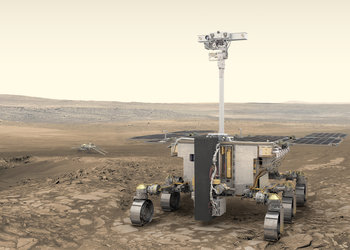Live updates: ExoMars arrival and landing
Updates from ESA’s space operations centre as the ExoMars Trace Gas Orbiter approaches and enters orbit around the Red Planet, and the Schiaparelli module lands on its surface
Updates on this page will cover the following expected milestones:
14 October: TGO final trajectory manoeuvre (08:45 GMT)
16 October: Separation of Schiaparelli from TGO at 14:42 GMT / 16:42 CEST
17 October: TGO orbit-raising manoeuvre at 02:42 GMT / 04:42 CEST
19 October: TGO Mars orbit insertion and Schiaparelli entry, descent and landing on Mars (atmospheric entry expected 14:42 GMT / 16:42 CEST, landing 14:48 GMT / 16:48 CEST)
20 October: Update on Schiaparelli status
21+ October: Schiaparelli status reports until end of mission
Note: Times shown above are actual event times at Mars; the one-way signal travel time between Earth and Mars is currently just under 10 minutes.
The events of 16, 19 and 20 October will also be livestreamed here, all other events will be reported on this page and via Twitter from @esaoperations, @ESA_ExoMars, @ESA_TGO and @ESA_EDM, and via the hashtag #ExoMars.
Refresh page for latest updates
21 October: NASA’s Mars Reconnaissance Orbiter has identified new markings on the surface of the Red Planet that are believed to be related to ESA’s ExoMars Schiaparelli entry, descent and landing technology demonstrator module. More details via: Mars Reconnaissance Orbiter views Schiaparelli landing site
20 October: Essential data from the ExoMars Schiaparelli lander sent to its mothership Trace Gas Orbiter during the module’s descent to the Red Planet’s surface yesterday has been downlinked to Earth and is currently being analysed by experts. More details in ESA press release: Schiaparelli descent data: decoding underway
19 October – Arriving and landing on Mars today!
20:55 CEST: The Trace Gas Orbiter (TGO) of ESA’s ExoMars 2016 has successfully performed the long 139-minute burn required to be captured by Mars and entered an elliptical orbit around the Red Planet, while contact has not yet been confirmed with the mission’s test lander from the surface.
More details in ESA press release: ExoMars TGO reaches Mars orbit while EDM situation under assessment
18:53 CEST: The ExoMars/TGO spacecraft completed its critical orbit-insertion manoeuvre at Mars today and its signals were received by ground stations at 18:34 CEST, just as expected. The timely re-acquisition indicates the engine burn went as planned, and mission controllers are waiting for a detailed assessment from the flight dynamics specialists at ESOC to confirm it.
Teams monitoring the Schiaparelli lander continue waiting for indication of the lander’s progress. Recording of the lander’s beacon signal during descent by ESA’s Mars Express orbiter was inconclusive. Engineers are waiting for the next signal receipt slot, which will be provided by NASA’s Mars Reconnaissance Orbiter, which will overfly the Schiaparelli landing site between about 18:49 and 19:03 CEST, and downlink any received signals at around 20:00 CEST.
18:35 CEST: ACQUISITION OF SIGNAL from the ExoMars Trace Gas Orbiter at 18:34 CEST, as expected, after it emerged from behind Mars.
17:28 CEST: According to nominal timeline, the orbit insertion manoeuvre of the ExoMars Trace Gas Orbiter should have ended but the spacecraft is now behind Mars on the line of sight from Earth. Acquisition of signal is expected when TGO emerges from behind Mars after 18:32 CEST.
17:12 CEST: End of planned Schiaparelli transmission. Initial signals were received via the Giant Metrewave Radio Telescope (GMRT) as Schiaparelli descended to the surface of Mars, but no signal indicating touchdown yet. This is not unexpected due to the very faint nature of the signal received at GMRT. A clearer assessment of the situation will come when ESA's Mars Express will have relayed the recording of Schiaparelli's entry, descent and landing.
16:50 CEST: Signals from Mars take 9 minutes 47 seconds to reach Earth today, so the teams are waiting for the first indications that the entry, descent and landing events actually happened at Mars. It may take some hours to get official confirmation that Schiaparelli has landed on the Red Planet. Stay tuned.
16:48 CEST: According to nominal timeline, the Exomars Schiaparelli entry, descent, and landing demonstrator module should now switch off its thrusters to avoid touching the surface with the heat plumes from the thrusters, or hitting a rock on the surface while the engines are still on. After switching off the thrusters, Schiaparelli should proceed to touchdown on the surface of Mars.
16:47 CEST: According to nominal timeline, Schiaparelli should be jettisoning its parachute & back shell, then igniting thrusters.
16:46 CEST: According to nominal timeline, the front shield of the heat shield protecting Schiaparelli should now be jettisoned.
16:45 CEST: According to nominal timeline, the Exomars Schiaparelli entry, descent, and landing demonstrator module should now be deploying its parachute.
16:43 CEST: According to nominal timeline, the Exomars Schiaparelli entry, descent, and landing demonstrator module should now be undergoing maximum heating.
16:42 CEST: According to nominal timeline, the Exomars Schiaparelli entry, descent, and landing demonstrator module should be entering the atmosphere of Mars now.
16:17 CEST: ExoMars Flight Director Michel Denis confirms that the signal from the Schiaparelli entry, descent and landing demonstrator module is coming through strong and clear as it falls gently towards Mars via the Giant Metrewave Radio Telescope (GMRT) near Pune, India.
15:43 CEST: Confirmation received that the Schiaparelli entry, descent and landing demonstrator module has woken up, as expected, ahead of attempting to land on Mars in about an hour. The confirmation arrived via a very faint signal received by the Giant Metrewave Radio Telescope (GMRT) near Pune, India.
15:15 CEST: Ignition of the ExoMars Trace Gas Orbiter is confirmed! The orbiter has started its main manoeuvre for Mars orbit insertion. The burn with the 424 newton engine on board is expected to last for about 139 minutes (over two hours) and will slow down TGO by over 5500 km/h in order to let the spacecraft be captured by the Red Planet's gravitational field.
14:41 CEST: The ExoMars/TGO orbiter is in great shape! ESA Flight Director Michel Denis is now on console in the Main Control Room at the ESOC mission control centre with the full mission control team for a 12-hour shift. TGO has begun turning away from Earth pointing to align its engine nozzle into the direction of flight. When it ignites (confirmation of ignition is expected on ground at about 15:15 CEST), its thrust will begin slowing the craft. The burn will last about 139 minutes. It is less than one hour until Schiaparelli wakes itself up at about 15:27 CEST.
07:35 CEST: The ExoMars/TGO orbiter is in great shape and ready to swing into orbit around Mars, while the Schiaparelli lander is programmed to wake up at about 15:37 CEST for its landing demonstration mission. There is a cooperative international 'listening in' campaign ready to monitor signals from the landing module as it conducts the critical entry, descent and landing sequence today, leading to touch down and the start of surface science at about 16:48 CEST. The Giant Metrewave Radio Telescope in India will listen from Earth, while a fleet of NASA and ESA orbiters listen from Mars orbit. Read details via Listening to an alien landing.
18 October – 1 day to arriving and landing on Mars!
16:30 CEST: The last day before landing and orbit entry is a quiet one for ExoMars/TGO and the Schiaparelli lander module. Since shortly after separation on 16 October, the lander has been ‘asleep’ and continuing its coast towards Mars landing. All commands for its entry, descent, landing and science mission were previously uploaded, and the next time it will become active is during wake-up about 75 minutes before it enters the martian atmosphere tomorrow. Atmospheric entry should begin at 16:42 CEST (onboard spacecraft time; the one-way signal travel time tomorrow will be 9 minutes 48 seconds).
At ESOC, the mission control team uploaded the final command sequence to the TGO orbiter this morning. This sequence will manage the spacecraft autonomously during its critical orbit entry manoeuvre, an approximately 134-minute-long main engine burn that will slow it sufficiently to be captured by Mars gravity. The manoeuvre is set to start at 15:04 CEST. No more commands will be transmitted to the craft until after completion of the orbit entry burn. The mission control team are sending periodic 'ping' commands – a null-value test command – that simply ensures the craft is 'alert' and that they could command it if needed.
Communication support today is being provided by ESA's 35m deep-space ground station at New Norcia, Australia, and Malargüe, Argentina, and by NASA's DSS 26 (Goldstone, California) and DSS 45 (Canberra, Australia) antennas.
More information on Mars arrival via these detailed blog posts:
Burn baby, burn! The technology of the Mars Orbit Insertion burn
How ExoMars/TGO gets to where it’s going
We also have a 'realtime' Schiaparelli entry, descent and landing animation, simulating the key moments during the module's six-minute descent to the surface of Mars. Watch it here or via YouTube.
08:20 CEST: The TGO's Mars Orbit Insertion manoeuvre commands were confirmed uploaded this morning at 07:35 CEST, ready for executing tomorrow. The insertion manoeuvre is planned to start at 15:04 CEST on 19 October. More details via 'Burn baby burn: the technology of the Mars orbit insertion burn' blog post.
17 October
15:45 CEST: The ExoMars/TGO orbiter and the Schiaparelli demonstration lander module are in good health and continuing, since separation yesterday at 16:42 CEST, on separate paths toward Mars. Schiaparelli is already on a trajectory that targets a landing in an area close to the equator known as Meridiani Planum. Following this morning's 11.6-m/sec orbit-raising manoeuvre, TGO has 'lifted' its trajectory so as to avoid the planet, while continuing to draw closer.
On Wednesday, TGO will conduct one of the most critical manoeuvres in its mission: a 139-min orbit entry manoeuvre planned to slow it by about 1.6 km/second (see "Burn baby, burn!"). Earlier today, the mission control team at ESA's ESOC operations centre configured TGO into a special mode for the orbit entry manoeuvre. The so-called 'fail-op' mode ensures that any routine problem that might arise − and that might trigger the craft to reset itself into 'safe mode' (which would shut down many ongoing activities, including propulsion) − will be ignored, so that the engine burn will in fact continue, more or less no matter what. The craft only gets one chance to enter orbit on the 19th.
Also today: mission controllers confirmed that TGO correctly received data transmitted by Schiaparelli during separation, and that the landing module had promptly gone to sleep shortly after being pushed away from the orbiter, as planned.
05:15 CEST: This morning at 04:42 CEST the TGO completed an orbit raising manoeuvre as planned. Without the manoeuvre, the spacecraft would, like Schiaparelli, remain on a collision course with Mars. Firing its engine for about 1m 46s raised the TGO’s orbit by several hundred km ‘above’ the planet, ahead of its planned orbit insertion on Wednesday. Signal with the TGO was reacquired after the burn, just after 05:00 CEST.
Click continue for previous days
16 October
18:43 CEST: Full telemetry link with ExoMars/TGO has been restored via ESA's 35m deep-space ground station at Malargüe, Argentina.
18:30 CEST: The Schiaparelli module was released from the Trace Gas Orbiter (TGO) at 14:42 GMT (16:42 CEST) as planned.
Today, three days before gravity will ensure the arrival of ExoMars 2016 at Mars, the Schiaparelli Entry, Descent & landing demonstrator Module separated from the TGO orbiter and is now en route on a ballistic trajectory to reach the Red Planet, enter its atmosphere and land softly in an area close to the equator known as Meridiani Planum.
However, TGO unexpectedly did not return telemetry (on-board status information), and sent only its carrier signal, indicating it is operational. The anomaly that prevents TGO's telemetry from being sent is under investigation, and is expected to be resolved within the next few hours.
An update will be posted in the next few hours.
17:27 CEST: ExoMars Flight Director Michel Denis confirmed that separation of Schiaparelli has occurred and and signals from TGO have been reacquired. The signals do not contain the expected telemetry (information on the onboard status), and the teams are investigating the situation.
17:02 CEST: Flight dynamics team at ESOC confirms separation of Schiaparelli from TGO on the basis of Doppler signal from the carrier. The Giant Metrewave Radio Telescope (GMRT) near Pune, India, has also recorded a very faint signal that indicates separation. Official confirmation expected soon when telemetry from TGO is received.
16:42 CEST: According to the timeline, Schiaparelli should have separated from TGO. Confirmation is expected on Earth soon and will be announced by ExoMars Flight Director Michel Denis once the data is on ground.
15:50 CEST: Both Schiaparelli and ExoMars/TGO are in good shape! The A-team shift of the mission control team are now on console in Main Control Room at ESOC. ExoMars/TGO has completed its slew into separation attitude/orientation. Communication now provided by ESA's 35m deep-space tracking station at New Norcia, Australia. Separation on track for 16:42 CEST.
13:25 CEST: The separation timeline has started! Teams at ESOC are extremely busy monitoring the sequence of events scheduled for today's separation, expected at 16:42 CEST. Both the ExoMars/TGO orbiter and the Schiaparelli lander module are in great shape. The lander has been switched on and engineers monitoring telemetry - on-board status information - report that temperatures on Schiaparelli are nominal. ExoMars/TGO has already begun slewing - rotating in space - into the correct attitude for separation. Just prior to separation, at 16:31 CEST, mission controllers expect to lose the full data link with TGO, and then will follow progress by monitoring the basic unmodulated carrier signal only, as a sort of beacon. We may also see signals received via the GMRT radio telescope in Pune, India, although this is strictly an experiment and may not function as planned. One-way signal time today is 9 mins and 34 secs.
10:10 CEST: Today, Schiaparelli, still attached to ExoMars/TGO, is switched on, and its systems checked out one final time. Experts from Thales Alenia Space (Italy) working at ESOC will verify the final set of time-tagged commands, which have been uploaded via TGO and stored on board Schiaparelli so that it can function more or less autonomously throughout its mission. TGO will eject Schiaparelli at 16:42 CEST, dispatching it on a three-day coast and a six-minute descent to the surface. Ground station coverage will be provided by NASA's giant 70m Deep Space Network (DSN) ground stations at Canberra, Australia, and Madrid, Spain, which will listen for the spacecraft's signals as the Schiaparelli module separates. It will be pushed away from TGO at just 30 cm/second, but this tiny push can be detected by the DSN stations.
15 October
At ESOC today: The ExoMars/TGO mission control team begins working from the large, general-purpose Main Control Room as of 02:00CEST. Activities include spacecraft health and status check-outs and ground station tracking passes to support the highly accurate 'delta DOR' navigation technique. By this evening, all files and configuration settings needed to support separation will be finalised. Separation is set for 14:42 GMT (16:42 CEST) spacecraft time tomorrow.
For separation, releasing a 577-kg lander will make TGO wobble. This could affect the very sensitive antenna pointing needed to ensure a full data link, so mission controllers will monitor progress only via the basic radio carrier signal, with the signal acting like a beacon. The separation wobble will be visible in the Doppler data associated with the carrier signal. With a one-way signal time of about 9 min and 45 secs, mission controllers will see a first indication of progress around 16:52 CEST. A full confirmation will come later (around 17:15 CEST) once controllers re-establish the full data link with the spacecraft.
14 October
18:35 CEST: Our coverage of separation on Sunday, 16 October, set for 14:42 GMT (16:42 CEST) spacecraft time, will begin a bit earlier than previously announced. You can watch a live webstream from ESA's mission control centre, Darmstadt, Germany, starting at 16:30 CEST.
14:05 CEST: The final pre-arrival orbit correction manoeuvre that took place at 10:45 CEST went very well. This burn was the last push needed to perfectly line TGO up on the right orbit to deliver Schiaparelli onto the surface three days after separation on Sunday. Flight Director Michel Denis reports a very tiny overperformance from TGO's thrusters, but the burn was overall very good. The next manoeuvre is scheduled for 12 hours after separation, at 04:42 CEST on 17 October, and will raise TGO's orbit above the planet.
10:25 CEST: This morning, the final pre-arrival team briefing was held at ESOC for everyone involved in ExoMars. Teams at ESTEC and from industry listened in via audio conference. The briefing was held to review and confirm readiness for separation on 16 October and arrival at Mars on 19 October. ExoMars/TGO orbiter and Schiaparelli demonstration lander health/status? Both GO for arrival. Schiaparelli is GO for entry, descent, landing and surface operations. TGO is GO for Mars orbit insertion. At our ESOC mission control centre: Simulation training complete; teams from Flight Dynamics, Flight Control, the ESA ground stations, networks and systems are all GO. NASA ground stations have also confirmed readiness to support. ESA's ExoMars Project Manager Don McCoy said: "People have put their hearts and souls into this. We're ready to go. Thank you to everyone."
08:50 CEST: This morning at 08:45 GMT (10:45 CEST) ExoMars/TGO will conduct the final orbit correction manoeuvre before separation on 16 October. The manoeuvre means that TGO's thrusters will be fired for a minute or so to deliver a change in speed and direction of just 1.4 cm/second. This burn will refine the already highly accurate orbit, and line TGO up to deliver Schiaparelli on to its intended landing site on Mars.










